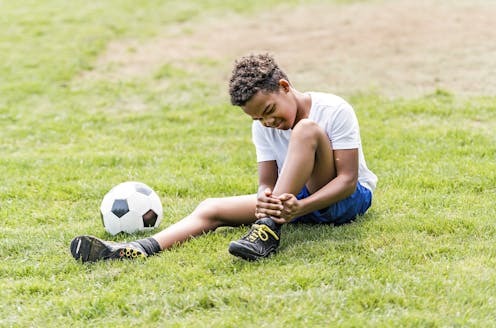Children experience more injuries, stress and even burnout when they specialize in one sport
- Written by Nirav Pandya, Associate Professor, Pediatric Orthopaedics and Sports Medicine, University of California, San Francisco

From football to baseball, gymnastics to tennis, more young athletes are becoming sports specialists. They join expensive sports clubs or youth leagues and devote themselves to a single sport all year long. But Nirav Pandya[1], a professor of orthopedic surgery and sports medicine at the University of California San Francisco, says there are risks when kids specialize, including an increased possibility of injury and a high burnout rate.
Dr. Nirav Pandya discusses the problems that can occur when kids specialize in one sport.The Conversation has collaborated with SciLine to bring you highlights from the discussion, which have been edited for brevity and clarity.
What trends do you see related to kids and sports participation?
Nirav Pandya: We’re seeing a tremendous number of kids[2] who are participating in sports outside of the school setting[3].
And kids are specializing in sports at younger ages. Six-, 7-, 8- and 9-year-olds are playing one sport year-round to the exclusion of other sports.
What are the outcomes for kids who specialize?
Nirav Pandya: When kids specialize, they have a significantly increased risk of injury[4].
We also know 70% of kids will drop out of sports[5] by age 13 if they specialize.
Also, in the long term, kids who specialize in a single sport perform less well in that sport and in all sports in general than kids who play more than one[6]. So once again, we’re really hurting kids from multiple different levels if they’re specializing.
What is the relationship between sports specialization and injuries?
Nirav Pandya: There’s a tremendous increase in traumatic injuries. ACL tears[7] used to be something we’d see in 17-, 18-, 19-year-olds. Now, 10-, 11- and 12-year-olds get them. The rate of ACL injuries has gone up 12% over the last decade[8] in this adolescent age group.
Based on my experience as a clinician, kids are also getting overuse injuries like knee pain and shoulder pain from doing too much of the same activity again and again.
Are clubs and leagues costly?
Nirav Pandya: The Aspen Institute has shown that families will spend, on average, about $1,000 per year[9] for these travel or private club sports. That’s a big financial burden for a lot of families.
In addition, the reason why a lot of families are doing this is because they want their kids to get a college scholarship[10]. Colleges are very expensive, and parents think if their child specializes in a sport and plays on these club teams, they can get to that level.
What families don’t understand is that the average four-year college scholarship amount is only $14,000[11]. And of all the kids playing sports, only 2% of them are actually going to get a college scholarship[12].
Is this mainly a problem for the rich?
Nirav Pandya: You have one group of kids who have access to sports because their families have the money and those kids are getting injured. And then you have another group of kids whose families don’t have the money to participate, and therefore there isn’t really an outlet for them to be physically active because school funding is going down[13]. Recreational programs don’t exist. So then those kids get the problems of diabetes, obesity and hypertension[14], and they carry that into adulthood.
What can parents do to ensure their kids have a healthy relationship with sports?
Nirav Pandya: It’s important for parents to understand the data. And that’s our role as physical therapists, athletic trainers and coaches – to understand that data and give it to parents.
I think the second thing is also not to feel the pressure to enter the youth sports complex, a US$15.3 billion industry[15]. Instead, donate to a community organization that is funding recreational sports, or try to push for your school to have those opportunities for your kids.
And finally, if your child is going to be playing travel sports or year-round sports, the parents should look at the websites of the club. Are they promoting kids to be healthy and active in a safe environment, or are they promoting kids to get a scholarship?
Watch the full interview[16] to hear more.
SciLine[17] is a free service based at the nonprofit American Association for the Advancement of Science that helps journalists include scientific evidence and experts in their news stories.
References
- ^ Nirav Pandya (orthosurgery.ucsf.edu)
- ^ tremendous number of kids (finance.yahoo.com)
- ^ outside of the school setting (www.complex.com)
- ^ significantly increased risk of injury (doi.org)
- ^ 70% of kids will drop out of sports (publications.aap.org)
- ^ kids who play more than one (doi.org)
- ^ ACL tears (www.mayoclinic.org)
- ^ up 12% over the last decade (projectplay.org)
- ^ about $1,000 per year (projectplay.org)
- ^ to get a college scholarship (www.cbsnews.com)
- ^ is only $14,000 (www.debt.org)
- ^ actually going to get a college scholarship (www.nfhs.org)
- ^ school funding is going down (doi.org)
- ^ the problems of diabetes, obesity and hypertension (projectplay.org)
- ^ a US$15.3 billion industry (time.com)
- ^ full interview (www.sciline.org)
- ^ SciLine (www.sciline.org)
Authors: Nirav Pandya, Associate Professor, Pediatric Orthopaedics and Sports Medicine, University of California, San Francisco


